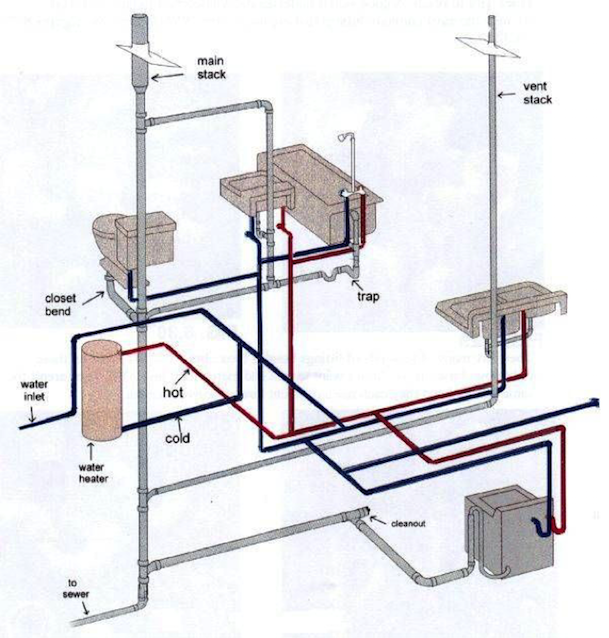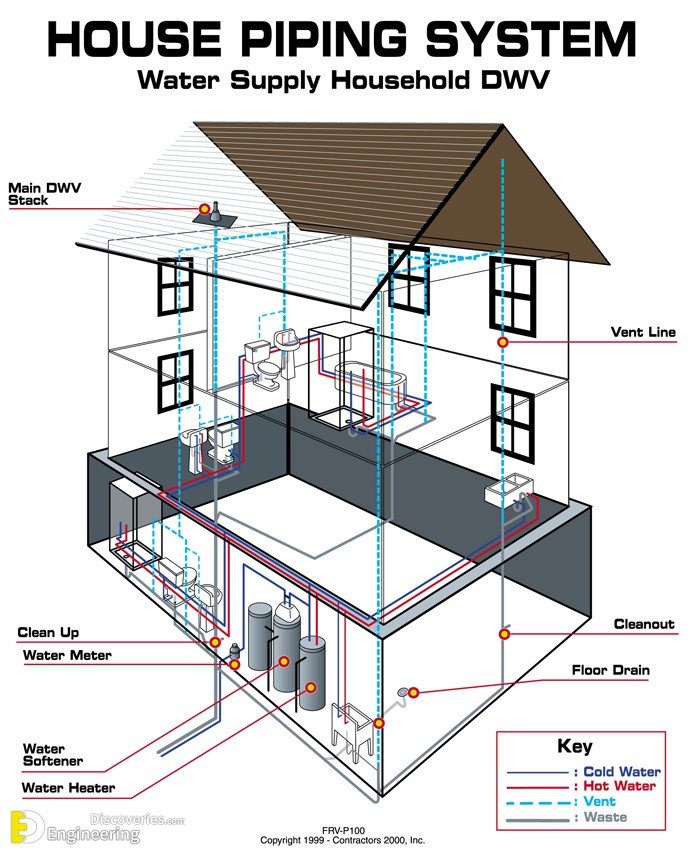Have you been hunting for critical info involving Understanding Your Home's Plumbing Anatomy?

Comprehending how your home's pipes system works is crucial for each homeowner. From supplying clean water for alcohol consumption, cooking, and bathing to securely removing wastewater, a well-maintained pipes system is crucial for your household's wellness and convenience. In this extensive overview, we'll explore the elaborate network that composes your home's pipes and deal tips on maintenance, upgrades, and handling typical issues.
Introduction
Your home's pipes system is greater than simply a network of pipes; it's a complex system that ensures you have accessibility to clean water and effective wastewater elimination. Knowing its components and how they work together can assist you avoid costly repair work and make certain everything runs efficiently.
Standard Components of a Plumbing System
Pipelines and Tubing
At the heart of your plumbing system are the pipelines and tubes that carry water throughout your home. These can be made from numerous products such as copper, PVC, or PEX, each with its benefits in regards to sturdiness and cost-effectiveness.
Fixtures: Sinks, Toilets, Showers, and so on.
Fixtures like sinks, commodes, showers, and bathtubs are where water is utilized in your house. Recognizing how these fixtures link to the pipes system aids in diagnosing issues and intending upgrades.
Valves and Shut-off Points
Valves manage the circulation of water in your pipes system. Shut-off shutoffs are essential during emergency situations or when you require to make fixings, allowing you to isolate parts of the system without interrupting water flow to the entire house.
Water Supply System
Main Water Line
The primary water line links your home to the local water or an exclusive well. It's where water enters your home and is dispersed to various fixtures.
Water Meter and Pressure Regulatory Authority
The water meter steps your water use, while a stress regulatory authority makes sure that water moves at a safe pressure throughout your home's plumbing system, avoiding damage to pipes and fixtures.
Cold Water vs. Hot Water Lines
Understanding the distinction between cold water lines, which supply water directly from the primary, and hot water lines, which carry heated water from the water heater, assists in troubleshooting and planning for upgrades.
Water drainage System
Drain Pipes Pipeline and Traps
Drain pipes lug wastewater away from sinks, showers, and toilets to the sewage system or sewage-disposal tank. Catches stop sewer gases from entering your home and additionally trap debris that can create blockages.
Air flow Pipelines
Air flow pipes enable air into the water drainage system, preventing suction that can reduce water drainage and trigger traps to empty. Correct air flow is crucial for preserving the integrity of your pipes system.
Value of Appropriate Drainage
Ensuring correct water drainage stops backups and water damages. Consistently cleansing drains and maintaining traps can prevent expensive repair work and expand the life of your plumbing system.
Water Heating System
Kinds Of Water Heaters
Hot water heater can be tankless or standard tank-style. Tankless heating units warmth water on demand, while tanks save warmed water for instant use.
Exactly How Water Heaters Connect to the Pipes System
Comprehending how hot water heater connect to both the cold water supply and warm water distribution lines helps in diagnosing problems like inadequate hot water or leaks.
Upkeep Tips for Water Heaters
On a regular basis flushing your water heater to remove debris, inspecting the temperature settings, and evaluating for leaks can extend its life-span and enhance energy efficiency.
Usual Plumbing Problems
Leaks and Their Reasons
Leaks can take place because of aging pipelines, loosened fittings, or high water stress. Resolving leaks promptly stops water damages and mold and mildew development.
Blockages and Blockages
Blockages in drains and bathrooms are frequently triggered by flushing non-flushable things or an accumulation of oil and hair. Utilizing drain screens and bearing in mind what goes down your drains pipes can prevent obstructions.
Signs of Plumbing Problems to Watch For
Low tide pressure, slow-moving drains, foul odors, or abnormally high water expenses are indicators of prospective pipes issues that should be attended to immediately.
Plumbing Upkeep Tips
Regular Inspections and Checks
Arrange yearly plumbing assessments to catch problems early. Look for indications of leakages, rust, or mineral buildup in taps and showerheads.
Do It Yourself Upkeep Tasks
Simple jobs like cleaning faucet aerators, checking for commode leaks utilizing color tablets, or shielding exposed pipelines in cool climates can stop major plumbing concerns.
When to Call an Expert Plumber
Know when a plumbing problem calls for expert proficiency. Attempting complicated fixings without proper understanding can bring about more damage and greater fixing costs.
Upgrading Your Plumbing System
Reasons for Updating
Updating to water-efficient components or changing old pipelines can improve water high quality, minimize water costs, and increase the value of your home.
Modern Plumbing Technologies and Their Advantages
Discover technologies like clever leak detectors, water-saving toilets, and energy-efficient hot water heater that can save money and decrease ecological impact.
Cost Considerations and ROI
Determine the ahead of time prices versus lasting savings when taking into consideration plumbing upgrades. Many upgrades pay for themselves with minimized energy costs and less fixings.
Environmental Effect and Preservation
Water-Saving Components and Devices
Mounting low-flow taps, showerheads, and toilets can significantly decrease water usage without sacrificing performance.
Tips for Decreasing Water Usage
Simple routines like taking care of leakages immediately, taking much shorter showers, and running full loads of laundry and meals can save water and lower your utility bills.
Eco-Friendly Plumbing Options
Consider lasting pipes products like bamboo for floor covering, which is durable and environment-friendly, or recycled glass for kitchen counters.
Emergency Preparedness
Steps to Take Throughout a Pipes Emergency situation
Know where your shut-off shutoffs lie and exactly how to shut off the supply of water in case of a burst pipe or significant leakage.
Value of Having Emergency Contacts Helpful
Keep contact information for neighborhood plumbings or emergency situation services easily available for quick response throughout a pipes situation.
DIY Emergency Situation Fixes (When Appropriate).
Temporary solutions like utilizing duct tape to spot a dripping pipeline or putting a container under a dripping tap can lessen damage till an expert plumbing arrives.
Verdict.
Comprehending the anatomy of your home's pipes system empowers you to keep it efficiently, conserving time and money on repair services. By following routine maintenance routines and remaining educated regarding contemporary plumbing modern technologies, you can ensure your pipes system operates efficiently for years ahead.
Exploring Your Homes Plumbing Anatomy
Water Supply System
Main Water Line: This is where water enters your home from the municipal supply or a private well. Water Meter: Typically located near where the main water line enters the property, it measures the amount of water used. Shutoff Valve: It s crucial to know where this is in case of emergencies. It allows you to turn off the water supply to the entire house. Pipes and Fittings: These distribute water throughout your home. Materials can include copper, PVC, or PEX. Drain-Waste-Vent (DWV) System
Drains: Located in sinks, showers, and tubs, these carry wastewater away. Traps: U-shaped pipes under sinks that hold standing water, blocking sewer gases from entering the home. Vents: Pipes that lead from the DWV system to the outside, preventing vacuum formation and allowing gases to escape. Sewer Line: Carries all wastewater from the home to the municipal sewer system or a septic tank. Fixtures and Appliances
Sinks, Toilets, and Showers Dishwashers and Washing Machines Water Heaters Maintenance Tips
Regularly check for leaks in exposed pipes and around fixtures. Inspect the water heater annually for signs of wear. Clean drains and traps to prevent clogs and odors. Know how to shut off water to individual fixtures. When to Call a Professional
Major leaks or burst pipes Installation of new pipes or fixtures Septic tank issues Remodeling projects that involve plumbing changes Conclusion
Understanding the anatomy of your home's plumbing is key to maintaining a functional and efficient system. Regular checks and knowing when to call in the experts can save you time, money, and stress.
https://www.mavyn.com/blog/exploring-your-homes-plumbing-anatomy

I am just very taken with The Inner Workings of Your Home's Plumbing and I hope you enjoyed our blog post. Are you aware of someone else who is interested in the topic? Be sure share it. I thank you for reading our article about Understanding Your Home's Plumbing Anatomy.
Schedule Estimate